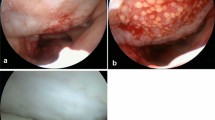Abstract
Purpose
Treatment of full-thickness cartilage defects in the hip is a major issue for orthopaedic surgeons. Autologous matrix-induced three-dimensional chondrocyte transplantation using three-dimensional spheroids (ACT 3D) may be an option for treatment. The aim of the study is to describe the feasibility and first clinical results of ACT 3D with spheroids at the hip.
Methods
In this report, the surgical technique was described for the first time, and the outcome of sixteen patients with chondral defects induced by cam-type femoroacetabular impingement (FAI) who were followed up in a prospective study was evaluated. All patients underwent physical examination before the first surgery and again before the second (about 6 weeks later). Further examinations were performed 6 weeks after the second surgery and at an average follow-up period of 16.09 months. At every visit, the non-arthritic hip score (NAHS) and the Western Ontario and McMaster Universities Arthritis Index (WOMAC) were obtained. In addition, patient satisfaction was evaluated during the last follow-up examination by means of a questionnaire.
Results
The NAHS and WOMAC scores had significantly improved 6 weeks after arthroscopic treatment of the cam-type FAI, and a further significant enhancement was seen 6 weeks after the second surgery with application of the chondrocyte spheroids. In the last follow-up, the mean results were equally as good as the second follow-up examination 12 weeks after surgery.
Conclusions
The present study shows that ACT 3D using spheroids is a feasible method that can be easily performed during arthroscopy. As the first results have been encouraging, the ACT 3D with spheroids at the hip should be continued. More studies should be initiated to get an impression of the quality grade of this method in comparison with other treatment options in case of chondral defects at the hip.
Level of evidence
III.




Similar content being viewed by others
References
Anderer U, Libera J (2002) In vitro engineering of human autogenous cartilage. J Bone Miner Res 17(8):1420–1429
Dienst M, Godde S, Seil R, Hammer D, Kohn D (2001) Hip arthroscopy without traction: in vivo anatomy of the peripheral hip joint cavity. Arthroscopy 17(9):924–931
Fickert S, Gerwien P, Helmert B, Schattenberg T, Weckbach S, Kaszkin-Bettag M, Lehmann L (2012) One-year clinical and radiological results of a prospective, investigator-initiated trial examining a novel, purely autologous 3-dimensional autologous chondrocyte transplantation product in the knee. Cartilage 3(1):27–42
Filardo G, Kon E, Di Martino A, Patella S, Altadonna G, Balboni F, Bragonzoni L, Visani A, Marcacci M (2012) Second-generation arthroscopic autologous chondrocyte implantation for the treatment of degenerative cartilage lesions. Knee Surg Sports Traumatol Arthrosc 20(9):1704–1713
Fontana A (2012) A novel technique for treating cartilage defects in the hip: a fully arthroscopic approach to using autologous matrix-induced chondrogenesis. Arthrosc Tech 1(1):e63–e68
Fontana A, Bistolfi A, Crova M, Rosso F, Massazza G (2012) Arthroscopic treatment of hip chondral defects: autologous chondrocyte transplantation versus simple debridement—a pilot study. Arthroscopy 28(3):322–329
Ganz R, Leunig M, Leunig-Ganz K, Harris WH (2008) The etiology of osteoarthritis of the hip: an integrated mechanical concept. Clin Orthop Relat Res 466(2):264–272
Ganz R, Parvizi J, Beck M, Leunig M, Notzli H, Siebenrock KA (2003) Femoroacetabular impingement: a cause for osteoarthritis of the hip. Clin Orthop Relat Res 417:112–120
Ilizaliturri VM Jr, Byrd JW, Sampson TG, Guanche CA, Philippon MJ, Kelly BT, Dienst M, Mardones R, Shonnard P, Larson CM (2008) A geographic zone method to describe intra-articular pathology in hip arthroscopy: cadaveric study and preliminary report. Arthroscopy 24(5):534–539
Karthikeyan S, Roberts S, Griffin D (2012) Microfracture for acetabular chondral defects in patients with femoroacetabular impingement: results at second-look arthroscopic surgery. Am J Sports Med 40(12):2725–2730
Konan S, Rayan F, Meermans G, Witt J, Haddad FS (2011) Validation of the classification system for acetabular chondral lesions identified at arthroscopy in patients with femoroacetabular impingement. J Bone Joint Surg Br 93(3):332–336
Lund B, Soballe K, Winge S, Holmich P, Jacobsen S, Lind M (2011) Hip arthroscopy. Ugeskr Laeger 173(3):197–200
Pestka JM, Bode G, Salzmann G, Sudkamp NP, Niemeyer P (2012) Clinical outcome of autologous chondrocyte implantation for failed microfracture treatment of full-thickness cartilage defects of the knee joint. Am J Sports Med 40(2):325–331
Philippon MJ, Schenker ML, Briggs KK, Maxwell RB (2008) Can microfracture produce repair tissue in acetabular chondral defects? Arthroscopy 24(1):46–50
Rossing S, Thermann H, Paessler H, Baum P, Schreyer T (2007) For discussion–new technique for arthroscopic, autologous chondrocyte transplantation using chondrospheres. Z Orthop Unfall 145(3):276–277
Sampson TG (2011) Arthroscopic treatment for chondral lesions of the hip. Clin Sports Med 30(2):331–348
Schubert T, Anders S, Neumann E, Scholmerich J, Hofstadter F, Grifka J, Muller-Ladner U, Libera J, Schedel J (2009) Long-term effects of chondrospheres on cartilage lesions in an autologous chondrocyte implantation model as investigated in the SCID mouse model. Int J Mol Med 23(4):455–460
Steimer O, Kusma M, Grun U (2011) Hip arthroscopy—indications and limits. Orthopade 40(12):1054–1060
Streich NA, Gotterbarm T, Barie A, Schmitt H (2009) Prognostic value of chondral defects on the outcome after arthroscopic treatment of acetabular labral tears. Knee Surg Sports Traumatol Arthrosc 17(10):1257–1263
Tannast M, Goricki D, Beck M, Murphy SB, Siebenrock KA (2008) Hip damage occurs at the zone of femoroacetabular impingement. Clin Orthop Relat Res 466(2):273–280
Umlauf D, Frank S, Pap T, Bertrand J (2010) Cartilage biology, pathology, and repair. Cell Mol Life Sci 67(24):4197–4211
Vanlauwe J, Saris DB, Victor J, Almqvist KF, Bellemans J, Luyten FP (2011) Five-year outcome of characterized chondrocyte implantation versus microfracture for symptomatic cartilage defects of the knee: early treatment matters. Am J Sports Med 39(12):2566–2574
Zaltz I, Leunig M (2012) Parafoveal chondral defects associated with femoroacetabular impingement. Clin Orthop Relat Res 470(12):3383–3389
Conflict of interest
The authors declare no conflicts of interest related to this study.
Author information
Authors and Affiliations
Corresponding author
Rights and permissions
About this article
Cite this article
Körsmeier, K., Claßen, T., Kamminga, M. et al. Arthroscopic three-dimensional autologous chondrocyte transplantation using spheroids for the treatment of full-thickness cartilage defects of the hip joint. Knee Surg Sports Traumatol Arthrosc 24, 2032–2037 (2016). https://doi.org/10.1007/s00167-014-3293-x
Received:
Accepted:
Published:
Issue Date:
DOI: https://doi.org/10.1007/s00167-014-3293-x




